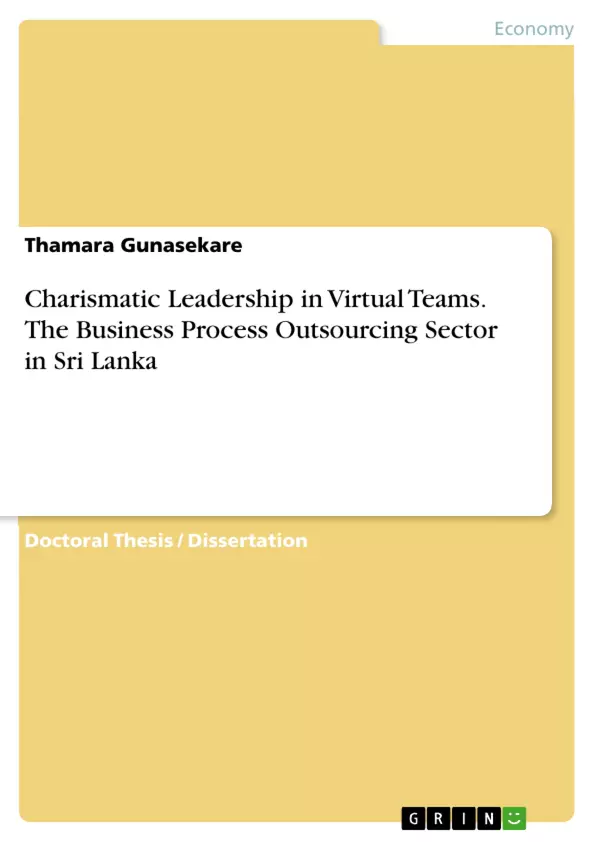The objective of the study is to explore the specific charismatic behavioural characteristics in leaders of virtual teams. The charismatic leadership model developed by Conger and Kanungo (1988) is the main theoretical framework for building this research argument. The Sri Lankan BPO sector was selected as the study setting and its virtuality was primarily tested using the virtuality index. The study is a mixed method research study and followed a sequential exploratory mixed method design.
The quantitative data was collected by a survey method using C-K scale and qualitative data collection was based on in-depth interviews and focused group discussions based on the questionnaire draws from the C-K scale. Factor analysis was employed to capture the behavioural characteristics of virtual charismatic leaders. Furthermore, the study found that charismatic leadership behaviours were present in the team leaders in BPO companies. The Factor Analysis created a new array of factors to describe the charismatic leadership behaviours in a virtual context.
The major contribution emphasized a new set of charismatic leadership behaviours present in leaders of virtual teams. A new model of virtual charismatic leadership was developed including seven behavioural characteristics. By comparing the charismatic behaviours of the Conger and Kanungo model and the proposed model, it was able to discover three behaviours that are unique to the virtual setting, to put forward the originality of the study: They are building trust in followers, the adaptive behaviour, and dealing with diversity.
This study added new dimensions to charismatic leadership and can be seen as an extension to the existing model of charismatic leadership of Conger and Kanungo (1998). Next, a detailed behavioural profile of virtual charismatic leaders was developed. In addition, to a concise conceptualization of virtual charismatic leadership it was also given to enrich the literature on leadership. The contribution to the knowledge and the implications were also elaborated, followed by future research directions.
Table of Contents
- CHAPTER ONE
- INTRODUCTION
- 1.1. Background
- 1.2. Research Gap
- 1.2.1. Theoretical Gap
- 1.2.2. Empirical Gap
- 1.2.3. Methodological Gap
- 1.3 Problem Statement
- 1.4. Research Questions
- 1.5. Objectives of the Study
- 1.6. Purpose of the Study
- 1.7. Significance of the Study
- 1.8. Methodology of the Study
- 1.8.1. Sequential Exploratory Design
- 1.8.2. Data Collection and Data Collection Instrument
- 1.9. Scope of the Study
- 1.10. Organization of the Chapters
- CHAPTER TWO
- LITERATURE REVIEW
- 2.1. Introduction
- 2.2. Leadership
- 2.3. The Concept of Charisma
- 2.4. Charismatic Leadership
- 2.5. The Main Theoretical Foundation - Attribution Theory of Charismatic Leadership
- 2.6. Development of Theories of Charismatic Leadership
- 2.7. Consequences of Charismatic Leadership
- 2.8. Charismatic Leadership Traits and Behaviors
- 2.9. Defining Virtuality
- 2.10. Virtual Teams
- 2.11. Effectiveness of Virtual Teams
- 2.12. Different Models of Virtual Teams
- 2.13. Advantages and Disadvantages of Virtual Teams
- 2.14. Leadership in Virtual Teams
- 2.15. Business Process Outsourcing Industry in Sri Lanka
- 2.16. Chapter Summary
- CHAPTER THREE
- PHILOSHPHY AND METHODOLOGY
- 3.1. Introduction
- 3.2. Research Framework
- 3.3. Research Philosophy
- 3.3.1. Rationale for Selecting Pragmatism as the World View for this Study
- 3.4. Method of Inquiry/Research Method
- 3.4.1. Rationale for Selecting the Mixed-Method Research
- 3.4.2. Purpose of Mixing Research Methods
- 3.5. Mixed Method Designs
- 3.6. Phase One - Quantitative Phase
- 3.6.1. Methods of Data Collection
- 3.6.2. Nature of the Survey Method
- 3.6.3. Form of Data Collection
- 3.6.4. The Population and Sample
- 3.6.5. Sampling Method
- 3.6.6. Sample Size
- 3.6.7. Instrumentation
- 3.6.8. Validity and Reliability of the Instruments
- 3.6.9. Administrating the Survey
- 3.6.10. Variables in the Study
Objectives and Key Themes
This dissertation aims to examine the nature and impact of charismatic leadership in virtual teams within the Business Process Outsourcing sector in Sri Lanka. It delves into the unique challenges and opportunities posed by virtual work environments, exploring how charismatic leadership styles influence team dynamics, performance, and overall success. The study seeks to contribute to the understanding of leadership effectiveness in a globalized and technologically advanced business landscape.
- The role of charismatic leadership in virtual teams
- The influence of charismatic leadership on team performance and effectiveness
- The challenges and opportunities of leading virtual teams in the Business Process Outsourcing sector
- The impact of cultural context on charismatic leadership in virtual teams
- The development of practical recommendations for effective leadership in virtual teams
Chapter Summaries
Chapter One provides an introduction to the research, outlining the background, research gap, problem statement, and objectives of the study. It also discusses the methodology employed, including the sequential exploratory design and data collection methods. Chapter Two presents a comprehensive literature review, exploring the concepts of leadership, charisma, charismatic leadership, and virtual teams. It examines various theories of charismatic leadership and its impact on team dynamics and effectiveness. The chapter also delves into the Business Process Outsourcing industry in Sri Lanka, highlighting its unique characteristics and challenges. Chapter Three elaborates on the research philosophy and methodology, detailing the chosen worldview of pragmatism and the mixed-method approach employed. It outlines the rationale for selecting the mixed-method research design and discusses the specific quantitative and qualitative methods used in the study. This chapter also addresses the data collection methods, sampling strategies, and instrument validation procedures.
Keywords
The key words and focus topics of this research include charismatic leadership, virtual teams, Business Process Outsourcing (BPO), Sri Lanka, team performance, effectiveness, attribution theory, mixed-method research, pragmatism, and cultural context. These terms reflect the central themes and research focus of the study, providing a comprehensive overview of the dissertation's scope and contribution to the field of leadership studies.
- Arbeit zitieren
- Thamara Gunasekare (Autor:in), 2018, Charismatic Leadership in Virtual Teams. The Business Process Outsourcing Sector in Sri Lanka, München, GRIN Verlag, https://www.grin.com/document/983253



